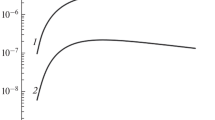Summary
A multichannel impact-parameter formalism is developed to describe the diffractive interaction of photons with nucleons. The Pomeranchuk contribution in high-energy Compton scattering and diffractive photoproduction processes is derived in an effective two-particle description satisfyings-channel unitarity and is found not to require the introduction of singular residues. The relation of this description to the conventional vector-meson dominance model is discussed, and an analysis of high-energy data on forward Compton scattering on protons and neutrons within this unitarized impact parameter framework is presented.
Riassunto
Si sviluppa un formalismo a molti canali del parametro d’impatto per descrivere l’interazione di fotoni con nucleoni. Si ricava il contributo di Pomeranchuk nei processi di scattering di Compton di alta energia e di fotoproduzione diffrattiva ricorrendo ad una descrizione effettiva a due particelle che soddisfa l’unitarietà del canales e si trova che esso non richiede l’introduzione di residui singolari. Si discute la relazione tra questa descrizione ed il modello convenzionale caratterizzato dalla prevalenza di mesoni vettoriali e si presenta nell’ambito di questa struttura unitaria del parametro d’impatto un’analisi dei dati di alta energia per lo scattering di Compton in avanti su protoni e neutroni.
Реэюме
Раэвивается многоканальный формалиэм прицельного параметра для описания дифракционного вэаимодействия фотонов с нуклонами. Выводится вклад Померанчука в комцтоновское рассеяние при высоких знергиях и процессы дифракционного фоторождения в зффективном двух-частичном описании, удовлетворяюшемs-канальной унитарности, и обнаружено, что не требуется ведение сингулярных вычетов. Обсуждается свяэь зтого описания с обшепринятой моделью доминантности векторных меэонов. Проводится аналиэ данных комптоновского рассеяния вперед на протонах и нейтронах при высоких знергиях в рамках рассматриваемого унитариэованного представления прицельного параметра.
Similar content being viewed by others
References
W. Drechsler:Phys. Rev. D,2, 364 (1970) (referred to as I).
W. Drechsler andR. Suaya:Phys. Rev. D,2, 1879 (1970).
W. Drechsler:Ann. of Phys.,73, 257 (1972) (referred to as II).
W. Drechsler:K-matrix absorption model for the pion nucleon system, preprint, MPI, München (October 1972),Ann. of Phys., to be published.
V. D. Mur:Žurn. Ėksp. Teor. Fiz.,44, 2173 (1963);45, 1051 (1963) (English translation,Sov. Phys. JETP,17, 1458 (1963);18, 727 (1964)).
H. D. Arbarbanel andS. Nussinov:Phys. Rev.,158, 1462 (1967).
H. K. Shepard:Phys. Rev.,159, 1331 (1967).
More exactly, a sense-nonsense point of wrong signature (compare Chapter 8.2 of ref. (8)).
W. Drechsler:Fortschr. Phys.,18, 305 (1970).
Compare in this context also ref. (9).
S. Mandelstam andL. L. Wang:Phys. Rev.,160, 1490 (1967).
In the case of Compton scattering (eq. (8a)) one finds also an additionalreal component of ℙ corresponding to triple-R exchange (compare Fig. 2b)) which turns out to be small as in purely hadronic interactions (see Sect.4).
TheB-terms give rise in this formalism to diffraction dissociation processes and real parts in high-energy elastic-scattering amplitudes which in purely hadronic processes are both known to be small compared to the dominantly imaginary elastic processes (compare ref. (1–4) and the discussion given there).
M. J. Creutz, S. D. Drell andE. A. Paschos:Phys. Rev.,178, 2300 (1969).
For recent investigations of this question in the framework of dispersion theory see ref. (11–14).
M. Damashek andF. J. Gilman:Phys. Rev. D,1, 1319 (1970).
C. A. Dominguez, C. Ferro-Fontan andR. Suaya:Phys. Lett.,31 B, 365 (1970).
M. R. S. Tait andJ. N. J. White:Nucl. Phys.,43 B, 27 (1972).
C. A. Dominguez, J. F. Gunion andR. Suaya:Phys. Rev. D,6, 1404 (1972).
J. J. Sakurai:Ann. of Phys.,11, 1 (1960).
H. Joos:Vector mesons and the electromagnetic interactions of hadrons, Schladming Lectures 1967, inActa Phys. Austriaca, Suppl. IV (1967).
G. Wolf: rapporteur’s talk, inProceedings of the International Symposium on Electron and Photon Interactions at High Energies, 1971, edited byN. B. Mistry (Ithaca, N. Y., 1971).
C. F. Cho andJ. J. Sakurai:Phys. Lett.,30 B, 119 (1969);Phys. Rev. D,2, 517 (1970).
See, for example, ref. (17,19,20). We, however, do not share the view expressed in ref. (19) concerning the two-component nature of the Pomeranchuk coupling for processes involving photons.
N. H. Fuchs:Phys. Rev. D,7, 186 (1973).
L. Stodolsky:Phys. Rev. Lett.,18, 135 (1967).
F. Cerardini, M. Conversi, S. D’Angelo, K. Ekstrand, M. Grilli, E. Iarocci, M. Nigro, L. Paoluzi, P. Spillantini, R. Santonico, V. Valente andR. Visentin:Analysis of the decay modes of the ρ’(1600)-meson, LNF-72/90, Frascati (October 1972).
H. H. Bingham, W. B. Fretter, W. J. Podolsky, M. S. Rabin, A. H. Rosenfeld, G. Smadja andG. P. Yost:Observation of a four-pion vector-meson state of mass =1.5 GeV produced by linearly polarized 9.3 GeVphotons, SLAC-PUB-1113 (September 1972).
W. P. Hesse: Thesis, University of California, Santa Barbara (1971).
A. M. Boyarski, D. H. Coward, S. Eklund, B. Richter, D. Sherden, R. Siemann andC. Sinclair:Phys. Rev. Lett.,26, 1600 (1971).
R. L. Anderson, D. Gustavson, J. Johnson, I. Overman, D. Ritson, B. H. Wiik, R. Talman, J. K. Walker andD. Worcester:Phys. Rev. Lett.,25, 1218 (1971).
G. Buschhorn, L. Criegee, G. Franke, P. Heide, R. Kotthaus, G. Pelz, U. Timm, G. Vogel, K. Wegener, H. Werner andW. Zimmermann:Phys. Lett.,37 B, 207 (1971).
Author information
Authors and Affiliations
Rights and permissions
About this article
Cite this article
Drechsler, W., Grifols, J.A. Diffractive scattering of photons from hadrons. Nuov Cim A 18, 55–74 (1973). https://doi.org/10.1007/BF02820837
Received:
Published:
Issue Date:
DOI: https://doi.org/10.1007/BF02820837



